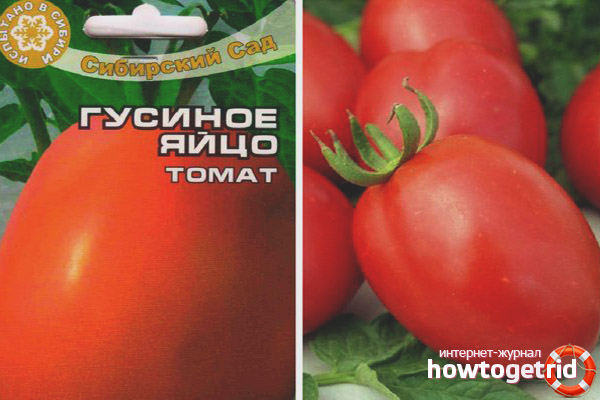The content of the article
The skin is dense and elastic. The fruits are fleshy, oval, red, with a high solids content. The taste is sweetish. These tomatoes are ideal for fresh consumption, as they contain a large amount of carotenoids, in particular lycopene. You can use goose egg tomatoes for preservation, fermentation, processing for juice.
Description
The plant is indeterminate, with unlimited shoot growth. Bushes can grow up to 2 m or more. Fruits are formed in brushes of 7-10 pieces. The bush is grown, as a rule, in two stems. The leaves have a saturated green color due to the high concentration of chlorophyll. Bushes need to be formed, stepsons removed, trimmed lower leaves. This plant is very decorative, especially during flowering and fruiting.
Cultivation and care
Sowing of seeds is carried out to a depth of three centimeters, on heavy soils up to two centimeters. After sowing, the hole is mulched, covered with a film or special material. After germination, the film or material is removed.
- With threats of freezing frost at night, the tomatoes take refuge. To get early tomatoes, they are grown through seedlings. Seedlings are transplanted into a greenhouse or open ground at the age of 50-55 days or when the first three to four leaves appear.
- At first, seedlings are covered with a film, a special covering material. Growing seedlings is easy. In cups (peat, paper, plastic), the planting mixture is poured, sown seeds, moisten the soil.
- Glasses with sown seeds are covered with a film and set in a warm, not too light, place until emergence. Shoots appear on the 7-10th day. After emergence, the film is removed, and the seedlings are moved to the light.
- For active seedling growth, a temperature of + 20-25 degrees is necessary. Transport to the ground under the threat of freezing frost is undesirable, plants die as soon as the temperature drops to +10 degrees.
When transplanting seedlings, half a bucket of humus and two large spoons of ash are added to the hole, all this is stirred and poured with water. Two plants are planted in the hole.
When grown indoors, overheating must not be allowed. It should withstand temperatures of + 23-25 degrees. Tomatoes do not require abundant watering.
Watering and feeding
The day after seedlings are planted or after emergence, the bed with plants is loosened to improve the water-air regime in the upper soil layer.
- Subsequently, two or three loosening is carried out until the tomatoes grow, covering the entire area of the garden.
- Top dressing is carried out before flowering and before the formation of fruits.
- The first feeding of tomatoes The goose egg is carried out with a solution that includes fifty grams of superphosphate, thirty grams of potassium nitrate and twenty five grams of ammonium sulfate per ten liters of warm, standing water.
- One liter of solution is poured under each bush. During the second feeding, a solution is prepared in the following composition: fifty grams of superphosphate and potassium nitrate per ten liters of water. Under each plant, up to two liters of solution is applied.
- For fertilizing, you can use organic fertilizers. Organic fertilizer consumption (mullein solution 1/10 or bird droppings solution 1/20, respectively) for the first feeding - two liters per plant, for the second feeding - up to four liters per plant. The interval between the first and second feeding is ten to twelve days.
- Watering tomatoes is carried out only with warm, standing water under the root.To improve the use of water when watering bushes around them in a circle make a rim of soil.
Watering is carried out in several stages, as water is absorbed. During fruiting, water consumption by the plant increases, so watering is carried out more often and more intensively.
During irrigation, it is undesirable to wet the soil under the fruits, they will rot from dampness. The Goose Egg variety has the property of overgrowing bushes. With strong growth, large leaves must be removed, for better illumination of the ovaries, and hence greater productivity.
Harvesting
Beneficial features
The Goose Egg variety is ideal for fresh consumption. The pulp contains virtually all the beneficial substances our body needs for health. Tomato is a natural storehouse of health. It contains proteins, carbohydrates, pectins, carotene, B vitamins, ascorbic acid, mineral salts of calcium, potassium, magnesium, iron.
Growing a goose egg variety will bring pleasure and positive emotions. It is only necessary to make small efforts to prepare the beds, seeds and provide simple care for the plants during their growth and fruiting.
Video: a super remedy for increasing the yield of tomatoes











Submit